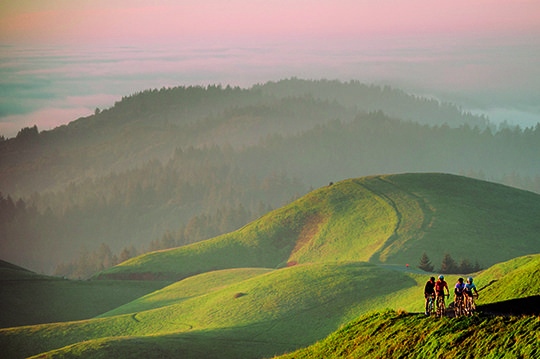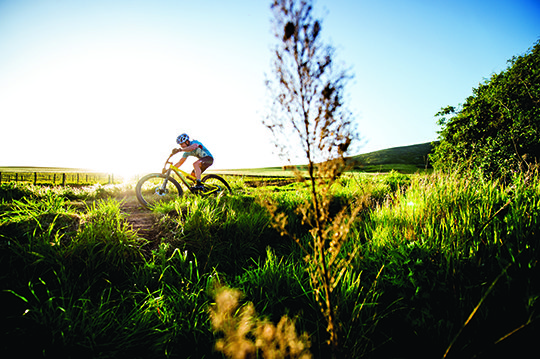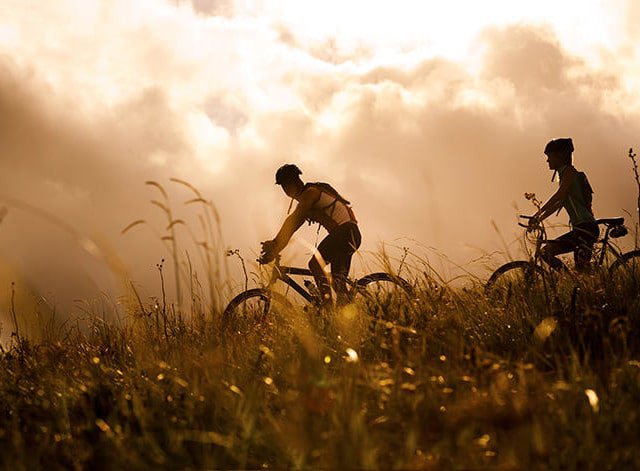How Strava Has Changed Cycling, Forever!
In 1996, there were 10 Strava guinea pigs in the entire world. Today, 5.3 activities are uploaded to Strava every single second of the year. In case you were wondering, there are 31 556 926 seconds in a year: that’s a fitload of uploads.
In 1996, there were 10 Strava guinea pigs in the entire world. Today, 5.3 activities are uploaded to Strava every single second of the year. In case you were wondering, there are 31 556 926 seconds in a year: that’s a fitload of uploads. By Jonathan Ancer

Cobus Swanepoel: if you’re reading this, know that you’ve ruined my day. It was going just fine until my phone pinged with a notification from Strava. Awesome, I thought, I wonder who just gave me kudos. But there were no kudos. Just a message, that read: “Uh oh! You just lost your KoM on Seaforth Kicker to Cobus Swanepoel by 3s.”
My King of the Mountain was gone. What had it shown? Only that I was the fastest cyclist in the world on a 500-metre stretch of Simon’s Town tar. I was in first place; pro rider Darren Lill was in third. Of the 28 478 times Seaforth Kicker had been ridden (by 7 905 riders), mine was the fastest. Okay, it’s possible Lill had stopped to fix a puncture, or he was on a recovery ride. But still. I had the KoM. It was mine. All mine. It had stood for almost four years: from 3 March 2012, until Cobus Swanepoel came roaring along on 18 February 2016 to snatch it away from me.
My cycling life can be divided into ‘BS’ (not that sort of BS), and ‘PS’. Before Strava (BS), I recorded my rides on an Excel spreadsheet. I would come home after a ride, switch on my computer, and painstakingly document my kilometres, my time, my heart rate, the weather, elevation climbed, a route description, comments about the ride (which included times for various sections of the route), and a running total of my mileage. OCD much?
My local ride is to the Blockhouse on Table Mountain, and my aim is generally to ride there from my home in under an hour. I’d record my time diligently, and had targets for various splits to meet my goal: Top of the Tar 24 minutes; Big Tree 34min; Quarry Junction 42min; Tafelberg Fork 51; Blockhouse… 59:58.
The point is that when first the buzz about Strava was heard in South Africa (it was launched in 2009, but really only became all the rage here in about 2011), I pooh-poohed it. Who needs Strava, I thought. I’ve got Excel!
Every so often I would print out my spreadsheets, pore over my data, compare months, and see which year I’d clocked the most mileage.
Then, one day, I was riding along with friends, just chatting and being sociable – when suddenly they put the hammer down. Was there a signal I didn’t know about? Then, just as suddenly, they got their chill back.
Turns out I hadn’t missed a signal – I’d missed a segment. A Strava segment.
After the ride we went for coffee; and before we’d even put in our order, my mates had whipped out their phones and were counting cups (personal records, not caffeine), to see how they’d fared against themselves, each other, and the world.
It was like they were talking another language: Stravish – and I was lost in translation. This is what it must feel like to be a pork sausage at a barmitzvah. Oh well, I thought. And decided to download the app – if you can’t beat them, join them, right?
But with that download, my cycling life changed forever.

Since the ‘Dandy Horse’ invented by Baron Karl von Drais in 1817 (Google it – I did. – Ed.), scores of technological developments have had a major impact on cycling. In the February issue of Bicycling we published an article about the evolution of bike tech, and documented how new bike designs, materials and components – as well as advances such as disc brakes, derailleurs and droppers – have seen lighter, stronger and more efficient bikes roll off the assembly line and onto our streets and mountains.
However, the innovation that has probably had the most impact on cycling itself is something that actually has nothing at all to do with bikes. It’s an app, and it’s called Strava. Okay, okay, I’m speaking for myself – but when I hit the button to record my first Strava ride, I was no longer just riding by myself: I was part of a multi-million-strong global cycling community.
Strive to Improve
Strava is the Swedish word for ‘strive’, which the Strava PR bumf says “epitomises who we are and what we do: if you’re striving to improve, no matter your goals or ability, you’re one of us.” In an interview with Outside Online, Strava’s co-founder Michael Horvath explained that after rowing at Harvard, he’d struggled to find the drive to train. “When you leave a sport, you realise that so much of what made you excited about being an athlete was the motivation you got from your teammates. You can’t replicate that. It’s hard to find eight guys to row with every day.”
So in 1996, he and Mark Gainey – a rowing teammate – discussed building “a kind of virtual locker room, where you’d log your workouts and people could see them”. Unfortunately, their idea was light years ahead of the available tech. Twelve years later, though, the Jobs/Gates/Zuckerberg steamroller had bashed its way into our virtual lives, creating all sorts of ways for people to link up, connect, follow, track and troll each other. With the tech now in place, Horvath and Gainey got 10 riders to upload their cycling data – gained from their GPS devices – to their computers.
“The feedback from these 10 guys was that it had changed their lives,” Horvath told Outside Online. “Every time they saw someone else upload a ride, they wanted to go out and ride again.” The app tracks you, documenting your mileage, elevation, and average speed; and then – and this is the bit that makes it different to other fitness apps, also the bit that makes it more addictive than crack – it ranks you on ‘segments’. Strava knows who else has ridden those segments, and ranks everybody according to time. The fastest gets a coveted KoM crown, and the app rewards you with a cup when you beat your personal record.
The Competitive Beast
Technology has changed the way we communicate (through status updates, and cat videos); travel (a ride is just an Uber away); hook up (swipe right); do business (with a click, remotely, and in global markets); and consume media (in 140-character chunks) – so why not the way we ride?
We’ve become a world of likers, re-tweeters, hashtaggers, sharers (and, I’m afraid to say, oversharers – no, Lindi, I do not want to see a picture of your kid making his first poo on the toilet). Before meals can be enjoyed they must be splashed onto Instagram; and something can’t be appreciated unless it’s ‘gone viral’.
And now, a ride didn’t happen if it’s not on Strava.
We perform better when we’re performing in public (well, all of us except Gareth Cliff), because – as the shrinks tell us – we get a tingle from being validated, affirmed and reaffirmed. And, of course, being in the public eye awakens the competitive beast inside us.
And this is what Strava does; it allows us to be competitive, wherever and whenever we want – whether we’re riding with a group, a mate, or just by ourselves. Creating a ‘To the Corner Café’ segment on Strava makes nipping out in tackies to get a loaf of bread into a contest.
Each segment has a leaderboard, and even if you’re low on the list, you race against yourself to achieve personal records, striving to improve on your best time.
However, says Dr Mike Posthumus, senior research officer at MRC/UCT’s Research Unit for Exercise Science and Sports Medicine, these leaderboards are sometimes best avoided. “For most of us, it’s not important where we are on the leaderboard. If you want to analyse your progression, rather compare your performance to your previous performances – the ‘My Results’ function for specific segments is excellent for gauging improvement.”
Posthumus suggests riders consider creating private segments, which means only your own rides will be shown. This, he says, is useful from an analysis perspective, to ensure that you are indeed progressing and getting faster.
He adds that you should make the most of the fact that your friends are watching you, to help you achieve consistency in your training. As it did for Horvath and Gainey’s Strava guinea pigs in 2008, today the Big Brother aspect of the app keeps riders super-motivated.
Although some riders have been a little too super-motivated. In 2010, 40-year-old William Flint was killed, speeding down a hill attempting to reclaim a KoM. His parents sued Strava for creating a “wild, wild West culture where [law-breaking] is encouraged and rewarded”. The suit was dismissed. In 2012, 37-year-old Chris Bucchere, attempting a Strava record, cycled through two stop signs and a red light, smashing into pedestrians and killing a 71-year-old man. Bucchere pleaded guilty to manslaughter, and was sentenced to community service with three years probation.
Of course, blaming the app for these incidents is like blaming a restaurant for not warning you that your coffee would be hot.

Challenges & Progression
Strava has challenges: riders can sign up to do a Gran Fondo, a once-off 100km or 120km ride. Or embark on a monthly climbing or distance challenge. Or tackle specific endeavours, like the ParisBrestParis Challenge, in which you are dared to ride 1 200km in the spirit of this iconic race. You’re given a unique finisher’s badge for every successful challenge conquered.
Posthumus, who has 65 KoMs under his belt (he didn’t tell me this – I confess, I stalked his Strava profile), believes Strava has changed the way we ride, and says it can be a valuable weapon in your training and analysis arsenal.
However, he points out, to make the most of the app’s analytical capacity, you need to upload all your rides, not just the ones that make you look good.
“Even your slow and recovery rides give you a valuable picture of your training history and performance over time. It’s not only your near-maximal riding that indicates performance; sub-maximal performance during your slow and recovery rides also yields interesting analysis. For example, progression during LSD rides will show similar but faster times over certain segments, at the same heart rate. Or vice versa; the same times with a lower HR will also indicate progression.”
He adds that not every ride has to be a smashfest. “You can’t simply go as hard as you can every time you cycle; you’re not expected to get PRs or KoMs on every ride. So be mature,” Posthumus warns; but adds that if you’re set to have a hard ride or to do intervals, then by all means, go for KoM glory. “Just, not on every ride.”
Pros, Cons, & Art
There are many Strava pros (and by ‘pros’, I mean advantages – though there are Strava professionals, too), but there’s also a flipside to the app. For example, while Strava certainly motivates you to push yourself, to achieve your goals and improve your performance, you may become too motivated and goal-driven to actually kick back and enjoy the ride – which, when you think about it, is kind of what cycling is actually all about. Or should be.
And of course, when you become a Strava addict, you’re lost when the technology lets you down. One morning, I woke up and had forgotten to charge my phone. Damn, I thought, now I won’t be able to Strava my ride. I’m ashamed to say that for a minute (okay, maybe even two), I contemplated going back to bed.
Also, because you’ve joined a virtual community, there may be less of a need to connect with real people to ride with – let’s face it, there’s something seriously antisocial about social media.
Strava has kept up with social media trends, adopting aspects of Facebook, like kudos (which is like, er, a ‘like’). There’s an Instagram-esque facility to upload photos from your ride; your followers can leave comments on your ride, and you can respond to them; and you can even share the details of your ride on other social-media platforms, for more widespread bragging.
All these features make Strava a powerful social-media tool, and I’m happy to use it as such – as long as I never get an invitation to play Candy Crush (yes, Lindi, I’m looking at you!) or FarmVille (stop it already, Lindi!!).
Another Strava spin-off is coming up with titles for your rides – and ‘Morning Ride’ and ‘Afternoon Ride’ no longer cut the mustard. While some riders choose practical names (like ‘Climbing Sprints’, or ‘10×30 Accelerations’, or ‘Recovery Ride’), another approach is to tell stories.
My mate Chris is, without doubt, the KOST (King of Strava Titles). A few of his gems include ‘The Shingle Track’ (at the time, he was suffering from, yes, shingles); ‘Albie Back’ (when he caught a rare glimpse of Albie, the albino squirrel who lives in a park near our regular ride); and my personal favourite, when we accidentally encountered each other at a junction on Table Mountain: ‘Finding the Ancer in an Unexpected Place’.
What’s more, the app has now given rise to Strava artists – riders who produce doodles with their routes. First, there were the inevitable schoolboy squiggles of some private parts but Strava art has become more sophisticated, with bicycles, unicorns, even wedding proposals.
Strava has turned a generation of cyclists into stats addicts, analysing rides to give us insights into our training, and comparing rides against ourselves, our peers and pros; and seeking (always seeking) cups for personal records, kudos from our mates, and – the cyclist’s holy grail – a King of the Mountain (thanks a lot, Cobus Swanepoel).
Which reminds me: if you need me, I’ll be at Seaforth Kicker, waiting for a tailwind.
READ MORE ON: Skills strava training programmes

